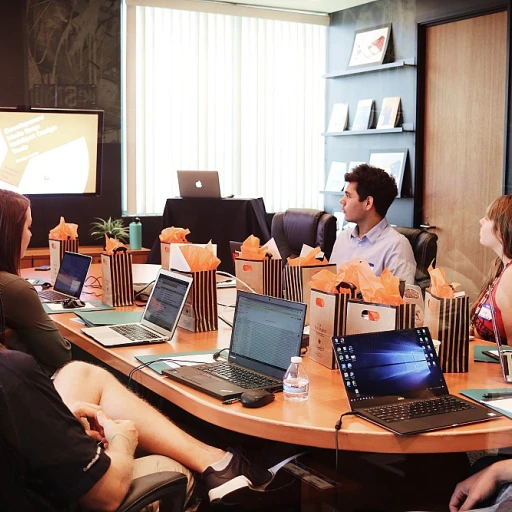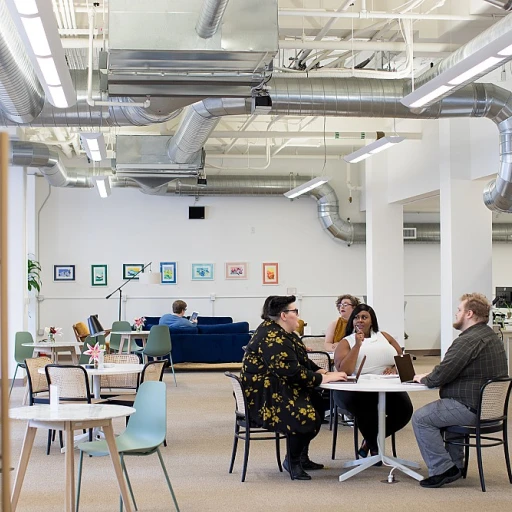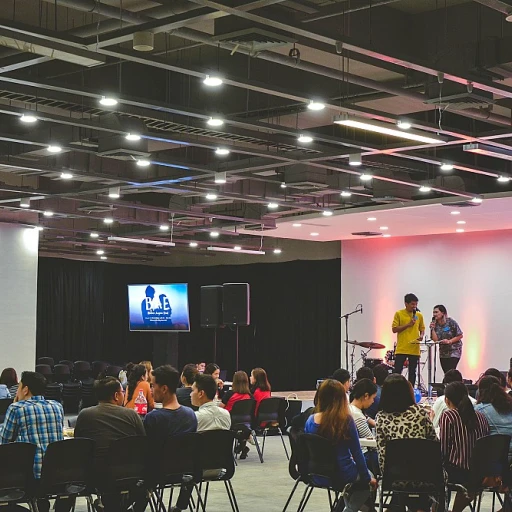
Understanding Generative AI in Workforce Training
Exploring Generative AI in Today's Workforce
Generative AI is revolutionizing the landscape of workforce training by offering dynamic, tailored experiences for employees across various sectors. As organizations seek to address the needs of a rapidly evolving workplace, embracing this technology becomes indispensable for business leaders. This powerful tool enables companies to create personalized content that aligns with the unique developmental requirements of their employees.
One of the core strengths of generative AI is its capacity to process and analyze vast amounts of data in real time. This capability allows it to identify patterns and recommend specific training programs that meet the specific needs of workers, thus enhancing workforce development. Such data-driven decision making not only optimizes the learning experience but also catapults organizations into the future work era.
Furthermore, the potential for generative AI extends into various domains, including customer service and public sector services. By providing timely insights and learning opportunities, employees are empowered to develop new skills and adapt to changes quickly. Companies implementing generative AI tools often report significant improvements in employee performance and satisfaction levels, evidencing the technology's impact on workforce engagement.
The Strategic Importance of Generative AI
As organizations continue to invest in human resources initiatives, the integration of generative AI into employee training programs becomes increasingly crucial. The technology not only affords flexibility but also promotes continuous learning and development opportunities, ensuring the workforce remains competitive and skilled. With AI's potential in training, enterprises can provide cutting-edge tools that equip their workforce to excel in diverse roles.
It's crucial, however, for companies to address challenges such as data privacy and data security. As AI technologies advance, ensuring compliance with regulations and maintaining ethical practices are imperative for protecting employees' sensitive information.
For further insights on leveraging generative AI for more effective upskilling, interested readers can explore our comprehensive guide, which dives deeper into operational strategies and best practices.
The Role of Generative AI in Upskilling
Generative Tools: Revolutionizing Employee Training
Generative AI is rapidly transforming the landscape of workforce training, offering businesses innovative tools and strategies to upskill their workforce. As technology evolves, organizations seek ways to leverage this potential to enhance training programs. Generative AI stands out as a pivotal solution, supporting the development of customized, data-driven learning experiences for employees.
At the core of generative AI's capability is its ability to process vast amounts of data, allowing companies to create content that is not only tailored to individual learning styles but also aligned with strategic business objectives. This personalization ensures that training is both relevant and engaging, helping employees retain information more effectively.
Enhancing Learning Through Data-Driven Approaches
Generative AI facilitates data-driven decision making in training development, providing insights that can help leaders design more effective programs. By analyzing the skills gap within their workforce, companies can better target areas of improvement, fostering a culture of continuous development. This approach is not just beneficial for individual growth but is crucial for the overall advancement of the organization.
Moreover, the integration of generative tools into training programs offers the flexibility to adjust content in real time. As businesses pivot and adapt to new challenges, generative AI ensures that the workforce is equipped with the latest skills, preparing them for the future work environment. This capability is especially valuable in industries where customer service and technological expertise are rapidly evolving.
Challenges and Opportunities
While generative AI holds tremendous potential in workforce development, it does bring challenges such as data privacy and security. Organizations must ensure that employee data is protected while using AI tools to avoid potential breaches. Nevertheless, with proper safeguards, the benefits in training employees with generative AI far outweigh these hurdles.
As companies and public sector organizations continue to explore the capabilities of generative AI, it's crucial to stay informed about the latest trends in enhancing language skills and other areas to maximize the potential of training programs.
Challenges Faced by Workforce Training Startups
Overcoming Operational Challenges
The integration of generative AI in workforce training presents numerous challenges that can hinder the success of businesses. Companies across various sectors face obstacles when implementing digital solutions in their training programs. Such challenges often revolve around technology adoption, data-related complexities, and employee engagement.
Balancing Technology and Human Elements
While generative AI offers remarkable potential for transforming how employees learn and develop, it also raises the issue of balancing technology with the human touch. Companies must carefully consider how generative AI affects employee training and development, ensuring that AI complements rather than replaces human interaction. The technology should empower workers to enhance their skills. It is essential for companies to maintain a balance where human resource departments work in tandem with AI, fostering an environment of collaborative skill-building.
Navigating Data Privacy and Security
Data security is a paramount concern as companies increasingly rely on data-driven approaches. Generative AI systems necessitate access to vast quantities of data to function effectively. This requirement brings challenges surrounding data privacy and security. Companies must take stringent measures to safeguard sensitive employee information, adhering to regulations as they develop training programs. Failure to ensure data privacy can lead to issues ranging from reduced employee trust to potential legal repercussions.
Encouraging Employee Engagement
Engagement is crucial in the success of training programs, yet it is another challenge companies face when integrating generative AI in workforce development. Business leaders often find it challenging to keep employees motivated and engaged with AI-driven training tools. There is a need for innovative approaches that incorporate real-time feedback and interactive content to retain employee focus. This requires a shift in conventional training methods to adapt to a digitally-rich learning environment.
For organizations seeking to effectively harness generative AI, understanding and addressing these challenges is paramount. By doing so, they can fully embrace the advancements in integrating agile solutions, thus paving the way for future work and skill development.
Case Studies: Successful Implementations
Examples of Generative AI Success in Workforce Training
Generative AI holds immense potential in transforming how organizations approach employee training. By leveraging advanced generative tools, several companies have made considerable strides in workforce development. Here, we explore a few examples where AI has been effectively integrated to enhance learning and training programs.
Enhancing Personalized Learning
One remarkable implementation of generative AI in workforce training is its ability to facilitate personalized learning journeys. Several tech-forward organizations have utilized AI to create customized training programs that adapt in real time to the unique needs of each employee. Such systems analyze employee performance data and adjust content dynamically, ensuring that workers remain engaged and that their skill development evolves efficiently.
Boosting Efficiency in Content Creation
A well-known financial institution implemented generative AI to expedite the production of training content. By automating the development of course materials, they significantly reduced human resources allocation for content creation. The AI generates relevant learning materials, which are then reviewed by experts to maintain quality and accuracy. This has resulted in a reduction of production time and has freed up staff to focus on higher-value tasks.
Improving Decision-Making with Data-Driven Insights
Generative AI has also made strides in improving decision-making processes within organizations. By harnessing the power of AI-driven insights, companies can make informed decisions regarding which skills to prioritize and develop in their workforce. AI analyses vast amounts of organizational and industry data to provide actionable insights. This strategic use of data aids business leaders in aligning employee skill development with future work trends.
Revolutionizing Customer Service Training
A renowned retail chain successfully implemented generative AI to enhance their customer service training. By creating simulated customer service scenarios using AI, employees practice and refine their skills in a virtual environment, reenacting real-world interactions. This immersive training experience enables workers to develop critical skills in handling various customer scenarios, resulting in improved customer experiences and higher satisfaction levels.
Future Work and AI Integration
The success stories of companies adopting generative AI emphasize its transformative potential. As the technology continues to evolve, the possibilities for innovation in employee training are boundless. With the continuous improvement and adoption of AI tools, the path to a more efficient and effective future work environment is becoming increasingly clear.
Future Trends in AI-Driven Workforce Training
AI's Evolution in Workforce Training: Glimpsing Tomorrow's Possibilities
The landscape of workforce training is evolving swiftly with the integration of generative AI technologies. Companies and organizations are keenly recognizing the potential this technology holds for transforming employee training and development. With AI advancing at a rapid pace, it's crucial to anticipate future trends that businesses must prepare for. Generative AI's capability to create dynamic, personalized training modules is at the forefront of these trends. In future work environments, training programs could become increasingly interactive, adapting in real time to the specific needs and pace of individual employees. This ensures that workers not only learn more effectively but can also apply new skills directly to their work, enhancing productivity and value creation. Moreover, as companies harness more data-driven approaches to training development, the role of AI in analyzing extensive data sets will be pivotal. Generative tools are expected to optimize decision-making processes, offering insights into which training methods are most effective and why. Business leaders can leverage such insights to continually enhance their training strategies and ensure they remain ahead of the competition. Data privacy and security will become an integral focus as AI technologies continue to permeate sectors ranging from human resources to customer service. Ensuring safe handling of sensitive employee data will remain a cornerstone of responsible AI deployment. As organizations prepare for these future challenges, understanding the balance between innovation and ethics will be key. Lastly, the public sector might witness increased adoption of AI for workforce development, catering to diverse needs across various populations, potentially minimizing skill gaps and driving broader economic growth. As we look towards the horizon of workforce training, it becomes evident that generative AI will be a catalyst for profound transformation. Companies and leaders must remain agile, adapting to new tools and technologies to harness AI's full potential.Practical Steps for Startups to Integrate Generative AI
Implementing Generative AI in Workforce Training Startups
Incorporating generative AI into workforce development is not just about adopting new technology. It requires a clear strategy, understanding of potential benefits, and addressing challenges like data security and privacy.To leverage generative tools effectively, consider these practical steps:
- Assessment of Current Capabilities: Begin by evaluating your existing training programs and workforce requirements. Identify skill gaps that AI-driven learning could fill. Understanding the areas of AI where it will have the most impact ensures a targeted approach.
- Data Management Strategy: Generative AI relies on data-driven insights. Ensure your organization has a strategy for collecting and managing data while prioritizing data privacy. Investing in robust data security measures will prevent breaches and maintain trust among employees and stakeholders.
- Employee Buy-In: Employees should be engaged throughout the integration process. Conduct workshops to educate workers about AI's role in development and its influence on future work. A transparent communication plan promotes acceptance among teams.
- Customization of Generative Solutions: Tailor-gen tools to align with specific organizational needs, focusing on improving decision-making and customer service, among other areas. Customization ensures generative tools fit the unique landscape of your business, maximizing their potential.
- Ongoing Training and Support: Continuous learning is essential. Provide training development programs for employees to use AI tools effectively. This supports workforce development by enhancing employee training in real-time, preparing workers for challenges ahead.
- Measuring Success: Establish metrics to evaluate the impact of generative AI on training outcomes. Consistent monitoring enables adaptation and ensures the alignment of generative solutions with business objectives.
By following these steps, organizations and leaders can effectively harness AI to transform their workforce training programs, promoting a culture of continuous learning and readiness for future challenges.












